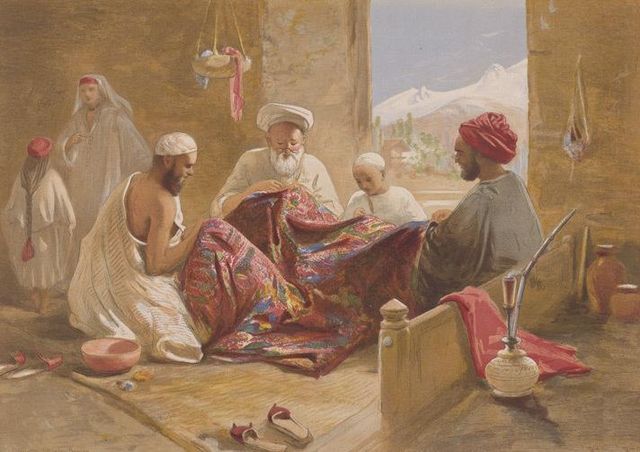 |
This is a file from the Wikimedia Commons. Information from its description page there is shown below.
Commons is a freely licensed media file repository. You can help.
|
Summary
| DescriptionMuslim-shawl-makers-kashmir1867.jpg |
English: Europeans prized cashmere shawls for the softness and warmth of the wool, the rich colours, the intricacy of the weave and designs. They were hand-made by men from fine 'pashm' wool, which was taken from the downy underfur of a Himalayan mountain goat (Capra hircus) and brought into India from Tibet and Ladakh in the summer season. From the 15th century, successive rulers of Kashmir, including the Mughals, continued the evolution of the shawl. Europeans then began to extend its popularity. The French sent patterns to agent's houses in Srinagar to be made up in Kashmir, based on general orientalist designs. The British largely preferred local designs: Lady Canning asked for traditional patterns in her order of 1861. One traditional design was the 'Char bagh ka namuna' or Pattern of the Four Gardens, made up of four separate pieces of differently coloured cloth.
|
| Date |
1867 |
| Source |
This chromolithograph is taken from plate 2 of William Simpson's 'India: Ancient and Modern'. Downloaded from the British Library Web Site.
Transferred from en.wikipedia |
| Author |
William Simpson |
Licensing
This is a faithful photographic reproduction of an original two-dimensional work of art. The work of art itself is in the public domain for the following reason:
| Public domainPublic domainfalsefalse |
 |
This work is in the public domain in the United States, and those countries with a copyright term of life of the author plus 100 years or less. |
|
This file has been identified as being free of known restrictions under copyright law, including all related and neighboring rights.
|
The official position taken by the Wikimedia Foundation is that "faithful reproductions of two-dimensional public domain works of art are public domain, and that claims to the contrary represent an assault on the very concept of a public domain". For details, see Commons:When to use the PD-Art tag.
This photographic reproduction is therefore also considered to be in the public domain. Please be aware that depending on local laws, re-use of this content may be prohibited or restricted in your jurisdiction. See Commons:Reuse of PD-Art photographs.
|
File usage
The following pages on Schools Wikipedia link to this image (list may be incomplete):
All five editions of Schools Wikipedia were compiled by SOS Children. In 133 nations around the world, SOS Children's Villages works to bring better education and healthcare to families in desperate need of support. Why not try to find out more about sponsoring a child?




